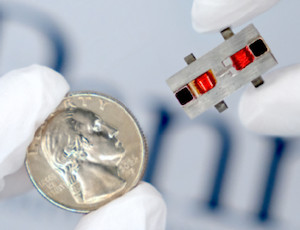
“What’s special about YIG is that it propagates a magnetic spin wave,” said research engineer Troy Olsson.
The team is researching filters for 6G communication in ‘frequency range 3’ – FR3, 7 to 24GHz. “At these higher frequencies, you may not always have a dedicated block of spectrum just for commercial use,” said Olsson, who is proposing tuneable filters as an alternative to switching across a bank of fixed filters.
Architecturally the device is a magneto-static wave filter, formed as a cavity micromachined from thin-film YIG, grown on a gadolinium gallium garnet substrate. Injection and output transducers are aluminium.
This occupies 200 x 70µm and is controlled by an in-plane magnetic bias perpendicular to magnetostatic wave propagation along the length of the YIG.
Tuning is achieved by altering the magnetic field, which comes from a combination of fixed NdFeB magnets, and AlNiCo magnets whose remnance, which is non-volatile, is adjusted using current pulses through coils wrapped around them.
In this way, power is only needed to vary tuning and not to hold a particular tuning.
The whole proof-of-concept including magnets occupies less than 2cm3. Insertion loss is between 3.2 and 5.1dB, and the out-of-band third order input intercept is >41dBm.
Read about the filter in the Nature Communication paper ‘Frequency tunable magnetostatic wave filters with zero static power magnetic biasing circuitry‘, which is clearly-written and can be read in full without payment.







